The importance of thoracic mobility in swimming and tennis
1 February 2022 | By Elyse Bradbury

How exciting has it been watching the Australian Open back in full swing! Go Barty!
As Aussies we love our summer sports, especially swimming and tennis. These activities are full-body sports that demand strength, coordination, conditioning, and flexibility. For optimal performance, swimmers and tennis players must possess good range of motion in both their upper and lower body. However, did you know that thoracic spine (mid-back) mobility also plays a crucial role in reach in the swimming stroke and tennis serve?
Have you ever noticed the impressive amounts of upper body rotation and arm extension professional athletes have when they’re lunging for those balls or finishing off the final 50m? These movements depend on a flexible thoracic spine and without that flexibility, injuries occur and performance is limited. Read on to learn how to both improve your swimming stroke and tennis game, and prevent injuries with good thoracic spine mobility.
Good thoracic spine mobility improves your swimming and tennis stroke
For tennis players and swimmers, thoracic spine rotation and extension are key. Great serves and beautiful freestyle strokes require athletes to maintain good shoulder alignment and scapular (shoulder blade) biomechanics, both of which rely in part on thoracic mobility. In fact, the shoulder only achieves its full overhead reach when the thoracic spine extends.
With all the time spent sitting at our desks, on the computer or reading our phones on the daily commute, our thoracic spines often become stiff and in a forward curve position (Thoracic Kyphosis). A stiff thoracic spine can create havoc with your swimming stroke. You will struggle to rotate through your spine and hips, leading to “fish-tailing” in the water. Then there is the overload created on your shoulder rotator cuff. A thoracic kyphosis leads to rounded shoulders, in turn changing the way your shoulder blade sits. This closes down the available range in your shoulders for that all important reach and early catch position. In the pool, optimal thoracic extension and rotation and an optimal scapular position lead to an increased capacity for reach, a better catch, more power through the stroke and reduced injury risk.
Did you catch Ash Barty’s backhand? Notice how her upper trunk twists to face one side of the court to the other. That shows the importance of thoracic rotation. And how high and far back she can reach before smashing an ace? That range of motion is only possible through thoracic extension.
As noted above, restrictions in thoracic mobility often lead to impaired scapular and shoulder motion. In tennis, this contributes to less power and an increased risk for injury. However, when thoracic mobility is ideal, an overall improved range of motion results in a harder hit on the ball because you achieve greater reach, wind-up, energy transfer and power.
Poor thoracic spinal mobility can lead to injury
In addition to improving performance, good thoracic spine mobility can prevent injuries. When motion is limited in one part of the body, another nearby body part overcompensates. Less motion in the thoracic spine leads to too much movement in the lumbar spine. Often this results in low back pain, inflammation, and/or lumbar disc issues. If you picture the amount of spinal extension needed for a serve, it’s easy to see why. When the thoracic spine lacks the necessary extension to reach the ball, the lumbar spine hyper-extends. Over time, this results in increased pressure and compression on individual lumbar vertebrae and can lead to injury.
Stiffness in the thoracic area also affects the shoulders and neck. Lack of necessary motion in the thoracic vertebrae often causes compensatory hypermobility or overuse pain in the shoulders and abnormal scapular movement patterns. In turn, these abnormalities can lead to rotator cuff tendinopathy or shoulder impingement; common swimming and tennis injuries. If the thoracic spine is stiff and unable to move with ease, the swimmer has to work harder to reach and rotate, so the shoulders begin working harder, increasing the risk of injury. The cervical spine (neck) attempts to compensate for restricted thoracic movement too, by lifting into extension and rotation in order to breathe, which can result in neck injuries.
Try this… sit slouched/ rounded in your thoracic spine and try to reach the hands directly over the head, arms straight. Can you feel the pressure in your shoulders or your lower back to achieve this reach? Now sit tall and open, stretching the crown of the head to the ceiling and reach above your head again. Can you notice how much easier that is?
6 simple stretches to improve your thoracic spine mobility
Here are a few simple stretches to incorporate into your routine to improve your thoracic spine mobility. As always, if you are unsure if these stretches are appropriate for you or you are experiencing pain with swimming or tennis please book an appointment with one of our Physiotherapists.
Latissimus Dorsi self-release
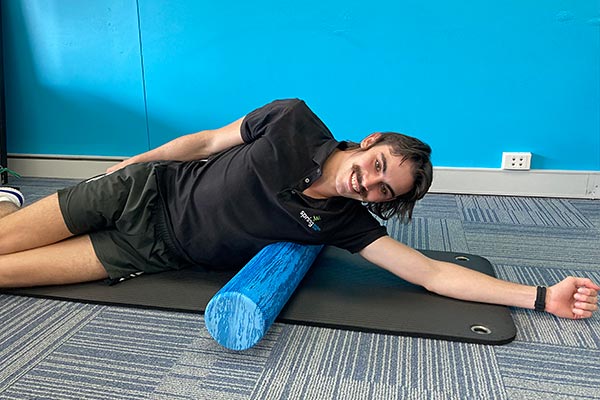
Position yourself on your side with underneath arm outstretched over a foam roll. Thumb is pointed up to pre-stretch the latissimus dorsi muscle. Movement during this technique is minimal. If a “tender point” is located, stop rolling, and rest on the tender point until pain decreases by 75%.
Book openers
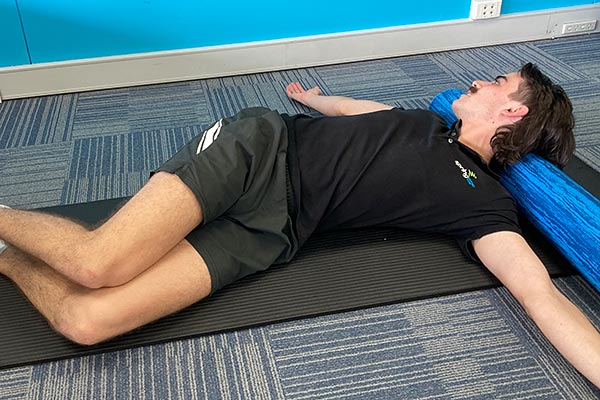
Lie on your side, knees bent. Reach the top hand to the ceiling. Exhale turn head and look behind, allowing body to follow head and arm backwards. Inhale hold. Exhale return to start position. Focus on rotating each vertebra one by one.
Thread the needle
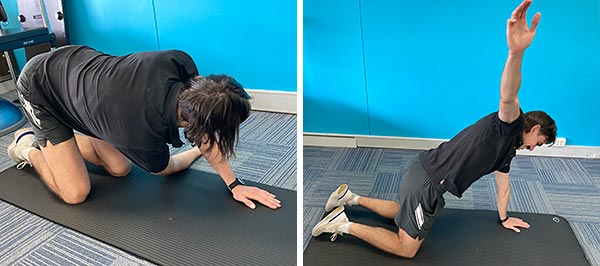
Start on all fours with your wrists under your shoulders and knees under your hips. Inhale as you lift your right arm up to the ceiling, while rotating your chest toward the right.
As you exhale, lower your arm back down as you twist your torso to the left, bending your left elbow to lower the right ear down to the floor. Take one breath here, then repeat. Perform a few reps on the right side, then do the same thing on the left.
Thoracic extension over foam roller
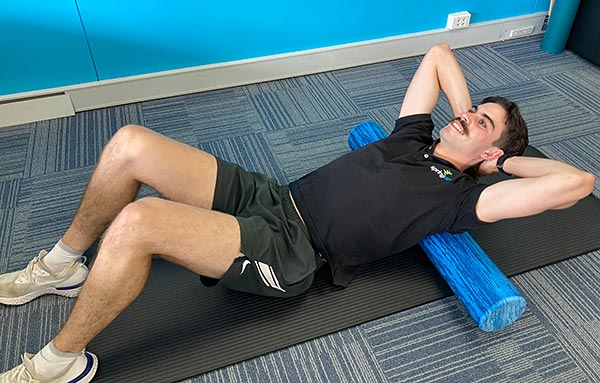
Start lying on your back with the roller just below your neck and your hands behind your head for support. Lifting your hips into the air, slowly roll back & forwards through your thoracic spine. Aim to relax over the roller whilst ensuring your low back remains straight; ie. don’t arch your low back.
Cat cow
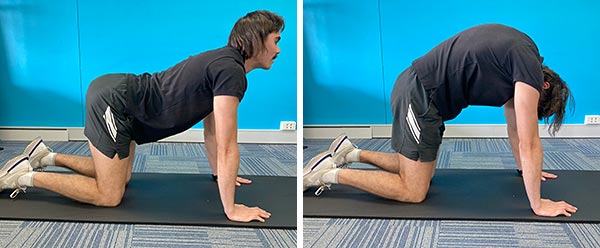
Keep your hands shoulder-width apart and your knees directly below your hips. Inhale deeply while curving your lower back downwards and raising your head and tailbone up (“cow”). Exhale deeply and draw in your abdomen, arching your spine and tucking your head and pelvis down ("cat."). Repeat several times.
Hip flexor stretches
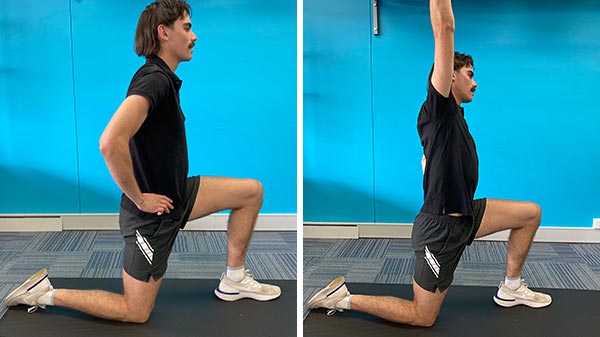
Kneel on your right knee with your left foot forward and left knee bent at a right angle. Tuck your tail bone under to flatten the lower back. Gently push your right hip forward into the stretch. Raise the arm on the right side to intensify the stretch.










